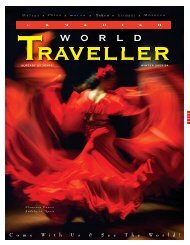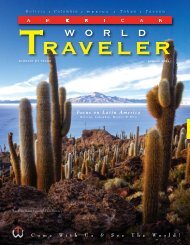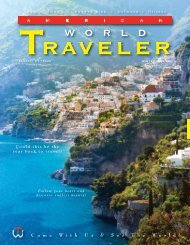Canadian World Traveller Spring 2024 Issue
Now in our 22nd year of publishing, World Traveler explores the culture and history of worldwide destinations, sharing the adventure of discovery with our readers and motivating them to make their travel dreams a reality. World Traveler helps sophisticated, independent travelers choose their next destination by offering a lively blend of intelligent, informative articles and tantalizing photographic images from the world’s best destinations, cruises, accommodations and activities to suit every traveler's taste.
Now in our 22nd year of publishing, World Traveler explores the culture and history of worldwide destinations, sharing the adventure of discovery with our readers and motivating them to make their travel dreams a reality. World Traveler helps sophisticated, independent travelers choose their next destination by offering a lively blend of intelligent, informative articles and tantalizing photographic images from the world’s best destinations, cruises, accommodations and activities to suit every traveler's taste.
You also want an ePaper? Increase the reach of your titles
YUMPU automatically turns print PDFs into web optimized ePapers that Google loves.
prayed, the vaulted room is a heavenly<br />
79<br />
place for breakfast. At the buffet we<br />
feasted on fresh fruits, meats, cheeses,<br />
yogurt and artisan breads. A fan of baked<br />
goods, I filled up on mini brioches with chocolate<br />
chips, shortbread cookies made by nuns<br />
from a local convent and Manchego flowers<br />
(or flores manchegas), a raised, flowershaped<br />
pastry of fried dough dusted with<br />
sugar and cinnamon.<br />
From the a la carte menu we could order piping-hot<br />
churros or eggs any style, but both<br />
days I went for migas, a humble dish that<br />
became a favorite of mine while traveling in<br />
Spain. A satisfying comfort food, migas combines<br />
fried crumbs from stale bread (soaked<br />
in water to get moist), olive oil, garlic, paprika<br />
(coloring it orange) and bits of chorizo. The<br />
crispy concoction is usually topped with a fried<br />
egg.<br />
Central Spain’s Parador de Cuenca!<br />
by Randy Mink<br />
Paradors are known for purveying the best in<br />
Spanish gastronomy, and the restaurant’s<br />
dinner menu features many dishes with traditional<br />
recipes from Spain’s Castilla-La<br />
Mancha region. Entrees include shoulder of<br />
suckling lamb, Manchego-style roasted lamb<br />
with rosemary sauce, and baked cod with<br />
Manchego ratatouille and saffron sauce.<br />
The word Manchego, known to North<br />
Americans as the name of a prized, semihard<br />
sheep’s milk cheese, also refers to the La<br />
Mancha region. The parador’s menu offers a<br />
selection of Manchego cheeses.<br />
For soaking up the heritage and<br />
romance of Spain almost by osmosis,<br />
nothing beats staying overnight in one<br />
of the country’s government-owned paradors.<br />
Many of the parador network’s 90-plus hostelries<br />
occupy former castles, palaces, fortresses<br />
and other types of historic buildings. They’re a<br />
big hit with North Americans seeking out Old<br />
<strong>World</strong> flavor.<br />
Both for its prime location and historical ambience,<br />
the 63-room Parador de Cuenca, once<br />
the monastery of San Pablo, makes an ideal<br />
home base in the enchanting city of Cuenca<br />
(see related article on page 8). Set on a rocky<br />
outcrop high above the Huecar River, the hotel<br />
affords postcard-perfect views of ancient<br />
buildings clinging to the cliffs across the<br />
gorge. Just steps from the entrance lies photogenic<br />
San Pablo Bridge, the gorge-spanning<br />
walkway that leads to the Ciudada Alta (Old<br />
City).<br />
A destination in itself, Parador de Cuenca was<br />
built in the 16th century by the Dominican<br />
order. The monastery was converted into a<br />
university in the 1800s and later served as a<br />
hospital, school and military headquarters.<br />
One of the hotel’s most striking features is the<br />
beautiful cloister that wraps around an openair<br />
courtyard where you can enjoy a drink on<br />
a summer evening. The arcades, graced with<br />
semi-circular arches, beamed ceilings and<br />
black-and-white-tile floors, are accented with<br />
antiques, including wooden chests and a<br />
grandfather clock.<br />
Also impressive is the restaurant’s coffered<br />
wooden ceiling. Once a chapel where monks<br />
Like the dining hall, the bar evokes the spirit<br />
of the old monastery. Just look up at the lovely<br />
religious ceiling frescoes framed by ornate<br />
plasterwork.<br />
Across the road are the tennis courts and outdoor<br />
swimming pool.<br />
The high-ceilinged guest rooms at Parador de<br />
Cuenca are tastefully appointed. My thirdfloor<br />
nest had a desk, TV, refrigerator and<br />
individual temperature controls. Red-tile<br />
floors and carved wooden doors lent a rustic<br />
look. In both the bedroom and bathroom,<br />
windows let in fresh air, allowing me to hear<br />
crowing roosters at the farmstead across the<br />
river.<br />
www.paradores.es<br />
<strong>World</strong> Traveler <strong>Spring</strong> <strong>2024</strong>















